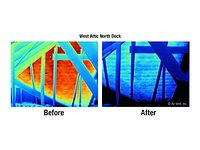
"Everything in a cartridge is caulk."
"The cheapest caulk is the best caulk."
"Caulking is a no brainer. Anyone who could pound sand in a rat hole can apply caulk."
Such comments may seem humorous to a room full of professional consultants or contractors-but these perceptions are more widely held on the jobsite than many of us would like to admit.
It is true that almost everything in a cartridge is a caulk. True sealants are less frequently used than caulks. Caulks are based on less expensive polymers such as linseed oil, polybutene, asphalt, butyl rubber, SBR rubber, vinyl acetate and acrylic latex. Caulks are a price-driven market where performance is often subordinate to economy. Sealants are a distinctly different class of product.
Before we get to the definition of a sealant, let's establish a working definition of a caulk:
A caulk has limited movement capability.
A caulk is a substance that, when used to fill a rectangular joint, can accommodate less than 12 percent movement in extension or compression without cracking, permanently deforming or delaminating.
A caulk has limited weathering properties. Caulks become hard and brittle and crack, split or severely chalk within three years.
Caulks often shrink, sometimes losing up to 30 percent of their volume from solvent loss, condensation or oxidation. Shrinkage applies excessive stress at the interface between the construction material and the caulk mass.
Caulks generally exhibit fair to poor adhesion on construction materials. Adhesion failure gets worse with increased volume shrinkage.
Caulks do not pass Federal Spec TTS 00230 or Canadian Spec CAN 19,13-M 82.
Let me add that if you paid under $2.50 a tube, you probably bought a caulk. Most caulks are designed for the "do-it-yourself" market, or should I say, the "do it to yourself" market. Homeowners have generally accepted caulk failure as part of life, and, since they are usually looking for a bargain, they seldom get their hands on a professional-grade sealant.
There are limited applications where caulks will do an adequate job, such as small seams with gaps of less than 1/4 inch across, or joints that are subject to little or no movement. Also, in buildings that require painting every four years re-caulking is not regarded as a liability, simply because expectations do not exceed the life of the paint.
Butyl caulks cure by solvent loss and tend to be more plastic than elastomeric. Butyl caulks have movement capability in dynamic joints, but don't recover well from extension, and often take a permanent set when compressed. Solvent loss and related shrinkage limit the use of butyl caulk to small joints.
Some butyl caulks perform well in small joints with less than 15 percent movement. To verify the quality of a butyl caulk, make sure it conforms to ASTM C 1085 and TTS-001657.
Acrylic latex caulks became popular in the 1960s. Many of these early sealants performed well in small joints such as residential siding and trim. Economic pressures have caused many formulators to use vinyl acetate as a copolymer or in blends with higher quality acrylic resins. These commodity caulks often have poor adhesion and weathering properties. Acrylic latex caulks are governed by ASTM C 834.
High Performance Sealants
In the building boom after World War Two, government specifications were introduced to establish performance standards for materials used on buildings that were insured, or paid for, with government funds. In the 1950s, Federal Specification TT-227B, for two-part synthetic rubber sealants, was issued to ensure "minimum property standards" for this class of material. The first types of elastomeric sealants regulated by these specs were based on polysulfide rubberPolysulfide Sealants
Polysulfide rubber was developed by the Thiocol Chemical Co. in 1929. Because polysulfide sealants have the longest record of field experience, they still occupy a significant share of the market today. Polysulfide is the only elastomeric sealant to have its own national specification, USAS 116.1 SS-S- 00200. To meet this performance spec, a 40 to 50 percent polymer content is required, making polysulfide sealants rather expensive for general contracting.
Polysulfide sealants contain no solvent and therefore exhibit no shrinkage. Their one disadvantage is that they are slow to cure. Polysulfides have a pungent mercaptan (rotten eggs) odor and almost always require a primer. Properly installed, polysulfide sealants can last up to 20 years with only slight surface cracking.
Silicone Sealants
Today, of the 113,000 metric tons of sealant used in construction, 88,500 metric tons are silicone. Almost all silicone sealants cure by exposure to moisture. Silicone sealants are usually clear or translucent, to coordinate with various colored building materials, and can also be pigmented to allow color matching. They cure faster than polysulfides and are capable of fairly deep cures.The first commercial silicones reacted with an acetoxy-cure mechanism that released a sharp acetic acid odor. The acetoxy-cure often resulted in corrosion on metal surfaces, and a neutral cure system based on an oxime reaction is now used where unprotected metal is involved.
There are now many formulators of silicone sealants, which have resulted in a wide range of performance. In general, the acetoxy-cure sealants hold their color better than the oxime-cure silicones. On the other hand, the oxime-cure products have the best adhesion and resistance to weather, though they often discolor.
Although silicone sealants generally have good adhesion, they have not always performed favorably in roofing applications where heat and oil migration from roofing substrates have tended to degrade adhesion. This is a big problem with cheaper acetoxy-cure silicone sealants that tend to be loaded with high amounts of filler.
Unfortunately, the use of cheaper grades of silicone in roofing has given the higher-performance oxime-cure silicone a bad name. One area where an oxime silicone has done well is in EPDM splicing where Carlisle SynTec has successfully used it as an "inseam sealant." Dow Corning, General Electric and Chem Link have oxime-cure silicones that have been successful in certain roofing applications.
Urethane Sealants
Polyrurethane sealants are based on the reaction products of (1) polyisocyanates containing two or more NCO groups, and (2) hydroxyl-bearing molecules containing two or more OH groups called "polyols." Urethane chemistry represents a very diverse group of polymer systems ranging from two-part to one-part moisture-cure and even one-part oxygen-cure sealants.In the early 1960s one-part urethane sealants were limited by slow cure rates, shallow depth of cure and shelf life problems. With improvements in formulation and packaging, shelf life problems were gradually improved. Urethane sealant reactions tolerate only the very small amounts of water vapor needed to sustain normal curing. Excess moisture from wet surfaces or rain often causes an undesirable side reaction in which CO2 is given off as a gas. Such "outgassing" reactions can cause the sealant mass to expand and even froth. When outgassing occurs, the urethane composition is seriously compromised.
Care must be taken to apply urethanes on dry surfaces only, and only when rain is not anticipated. Low-cost urethane sealants based on aromatic isocyanates are subject to discoloration ("suntanning") after ultraviolet light exposure. More expensive aliphatic isocyanates are now available when color stability is a requirement.
The 1970s brought improvements in single-component urethane technology with better adhesion promoters, improved antioxidants and better UV stabilizers. The ‘80s introduced improved cure technology that offered faster skin-over times, greater elongation and better low-temperature mechanical properties.
The cost/performance attributes of urethane sealants accelerated their popularity in both highly specified and non-specified applications. Today, one-part urethanes represent 20,000 metric tons of the 130,000 metric-ton construction market. The continued efforts of sealant formulators have now improved urethanes to the upper limit of their potential.
In the 1980s the roofing industry, with the advent of single-ply membranes, needed to upgrade its use of asphalt sealants to an elastomeric sealant with adhesion to EPDM rubber, PVC and polymer-modified bitumen membrane.
Single-ply membranes and longer warranty requirements induced roofing contractors to begin using the more expensive urethane sealants. Today urethane sealants are specified in many single-ply roofing details where they are used extensively in flashing, termination bars, reglets, coping and pitch pans.
Competition in the urethane sealant market is intense, and this has led to a wide disparity in quality. Those urethane sealants that conform to TTS- 00230 are most likely to perform well in roofing or general construction. As a general rule, the cheaper the price, the more doubtful the performance. Vulkem, NP-1 and Sika urethanes are used extensively in roofing.
Polyether "MS" Sealants: "The Next Generation"
This is a newer class of moisture-cure sealants based on a polyether backbone and two or more reactive methyl silyl end groups. Polyether sealants skin over and cure much faster than silicones and urethanes, and therefore exhibit very little dirt pickup. They also cure much deeper than urethane.Polyether sealants with very low modulus (soft) are now available. These low-modulus materials are capable of up to 1,000 percent elongation and offer greater durability in large dynamic joints than either silicone or urethane. Very little moisture is required to trigger a rapid polymerization reaction in polyether sealants.
Application temperatures as low as 30 degrees F can extend the construction season for contractors working in cold climates by two to three months. Also, moisture contamination on joint surfaces cannot cause the kind of outgassing reactions seen with urethanes.
Adhesion with polyether sealants is much better than urethanes and equal to the best silicones. Primers are occasionally specified. Weather resistance is equal to that of the three dominant polymer sealants. A service life of somewhere between 20-30 years is predicted.
Because polyether-based sealants are made without any volatile organic solvents, shrinkage and related surface stress is eliminated. Polyethers contain no carcinogenic material and conform to California's Proposition 65. These are the most environmentally and OSHA-compliant sealants on the market today. They are also the most forgiving and roofer-friendly materials available.
Only 1,800 metric tons of polyether polymers are presently used out of the 113,000-metric-ton sealant market dominated by silicone, polysulfide and urethanes. Polyethers are competitively priced between urethanes and oxime-cure silicones.
As contractors and specifiers become familiar with the attributes of polyether MS type sealants, they will rapidly displace the older, more familiar, technologies that now dominate the sealant market.
Specification
Usually specification writers define appropriate applications for sealants. Unfortunately they often write prescriptive rather than performance specifications. For example, when polysulfide sealants were at the peak of their market life it was difficult to get a silicone or a urethane with better potential performance specified, because the prevailing specifications only allowed polysulfide sealant as a generic requirement. In time, other polymer types were accepted.In my opinion, there are many roofing applications where polyether sealants would perform better than urethane. However, the NRCA Roofing and Waterproofing Manual specifies urethane on every one of its single-ply detail drawings. I believe that NRCA should specify sealant performance that meets or exceeds a TTS-00230.
The following are some rules of thumb for specifying roofing sealants:
On asphalt: use an asphalt caulk.
On modified bitumen: use a modified bitumen mastic. In critical areas where movement is anticipated, use a good grade of urethane or polyether sealant.
On EPDM: use a solvent-based EPDM lap seal caulk on splice joints. On flashing: use polyether sealants. Urethane sealants usually don't adhere to EPDM.
On PVC: use a polyether sealant, urethane or an oxime-cure silicone.
On Hypalon (less than six months old): use only fresh Hypalon sealant. On weathered Hypalon: don't attempt to use a sealant; it will probably fail.
On TPO: use a urethane or polyether only with an effective primer. Carlisle and Chem Link have an effective TPO primer.
On polyurethane foam: use urethane, oxime-cure silicone or polyether sealants.
On most metal roofs: urethane or oxime-cure silicone (non-corrosive) and polyether sealants work well.
On Kynar (polyvinylidine flouride)-coated metal: oxime-cure silicone works well. Urethane does not bond at all to Kynar.
Avoid using caulk on all single-ply membranes.
Workmanship
Sealant application is like welding. The best and most appropriate sealant in the wrong hands can lead to failure. Allow only experienced people to work on sealant applications. Poor workmanship can affect a warranty-or even your company's reputation. Just as welding rod companies don't warrant a welder's work, don't expect a sealant manufacturer to warrant your employees' work.Environment at the time of application can have a significant influence on sealant performance. Urethane sealant manufacturers restrict the use of their product to temperatures above 40 degrees F. Silicones are also limited to 40 degrees F. Polyethers work well down to 30 degrees F. Rain can have a detrimental effect on sealant performance, especially with urethane. Polyethers skin over rapidly and are virtually unaffected by rain.
Surface preparation is always important. Remove all contamination that could interfere with adhesion. Previous sealant applications must be thoroughly cleaned out.
Urethane and polysulfide sealants will not adhere to a surface contaminated with silicone sealant. Silicone and polyether will adhere to such contamination; however, a rigorous clean-out of the joint with a wire brush will help ensure success.
Solvent scrubbing can have varying effects on different sealants. Xylene works well for urethane and polysulfide because these polymers are miscible in aromatic solvent. Don't use aromatic or aliphatic solvents prior to bonding with silicone or polyether. These solvents leave an oily residue that interferes with adhesion. Alcohol, acetone or MEK work best for silicone and polyether.
Adhesive strength should exceed the cohesive strength of a sealant.
Primers are required where joint movement above 50 percent is anticipated or where severe weather, salt or immersion in water can drive moisture into a joint.
Most commonly used primers are based on silane coupling agents such as amino-silanes and epoxy-silanes. These are dissolved in a solvent for ease of application and for penetration into porous materials. Check with the sealant manufacturer for the most appropriate primer. Amino-silane coupling agents work best with silicone, polyether and most urethanes. Mercapto-silane coupling agents are used for polysulfide.
Because of their reactive properties, primers often have hazards associated with them. Read the MSDS (material safety data sheet)! When in doubt, always use impermeable rubber gloves and eye protection. Avoid skin contact.
Metals often require special consideration. Aluminum oxidizes rapidly and becomes almost unbondable when coated with oxide. Sanding and cleaning the bonding surface along with a suitable primer will ensure success. Copper ions can be detrimental to the properties of some urethanes and polysulfides. Call the manufacturer. Corrosion on iron must be removed.
Kynar-coated metal must be sanded and primed for use with urethanes. Certain oxime-based silicones, and some polyethers, will bond to Kynar without sanding.
Tooling determines the quality of the weathering surface. Many contractors wet a finger and form a concave surface on the metal. On very small right angle joints you can get away with this expedient technique. Where movement is severe, tooling to a flat surface minimizes stress on the sealant. In some larger right angle joints, a convex surface is sometimes specified to further minimize stress. These finishes can only be accomplished with appropriate metal or plastic tools. When sealing large joints it is necessary to tool surfaces as soon as possible. This is especially important on hot, damp days when fast setting moisture-cure sealants such as polyethers can skin over quickly.
As roofing materials and systems become more sophisticated, sealant performance and workmanship assume a more critical role. The skilled use of sealants is often the hallmark of a strong, successful high-tech roofing company.



